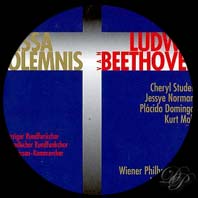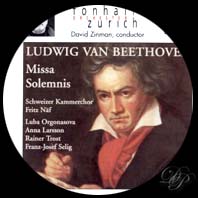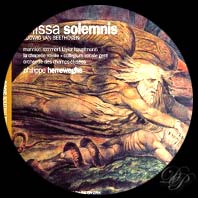| |
 |
| |
|
| |
The Missa Solemnis of Beethoven, in D major (his second mass) is a monumental work, not only in its length, nearly 80 minutes, but above all by its content, absolutely stupefying. With the Mass in B minor of J. S. Bach, it is one of the two summits of all sacred music. Note the difference between the two, Beethoven’s Missa Solemnis does not have one air for soloists: it is essentially a choral work, with active participation of the soloists. This complex work is not easy for the listener, unlike other works of Beethoven, such as the concertos and symphonies. Its approach and its comprehension require a number of hearings. Fortunately, today’s listeners have the privilege to listen to, and re listen to the recordings made by the great conductors, with prestigious singers, choirs and orchestras of the highest level. It is seldom played in concert, much less than it should. As for its performance in church, at the time of the mass, it is even rarer. |
Beethoven dedicated much of his time and energy to the composition of this work: it was nearly four years before he finished it. Beginning in April 1819, it was originally intended for the instillation of the Archduke Rudolph, as Archbishop of Olmutz, anticipated for March 1820. In fact, the work did not achieve its premier until March 1823. The long labour resulted in an incredible work, remarkable for its thematic, harmonic, rhythmic, vocal and orchestral plan. The first partial hearing (Kyrie, Credo, Agnus Dei), was all that was heard at the concert on 7 th May 1824. The concert also included his opus 124, the overture “Consecration of the House” and the opus 125, the 9 th Symphony. The first edition dates from 1827. At the start of the Kyrie, which opens the work, Beethoven wrote: “Vom Herzen, möge es wieder, zu Herzen gehen!” which can be translated as: “From the heart, may it go further, to the heart!” or better: “Arising in the heart, may it return to the heart!”. |
The necessary forces for this work: - 4 great singers: soprano, alto, tenor, bass; - a large choir of 4 voices; - an important orchestra constituting:
|
I – KYRIE (length: 9 to 11 minutes).1 – Assai sostenuto, Mit Andacht (with piety).
2 – Andante assai ben marcato.
3 – Tempo primo.
II – GLORIA (length: 16 to 18 minutes).This section is, in itself, a master work. It is divided into 8 parts, all connected. 1 – Allegro vivace “Gloria In Excelsis Deo”.
2 – Meno allegro “Gratias”.
3 – Allegro vivace “Domine Deus”.
4 – Larghetto “Qui Tollis”
5 – Allegro maestoso “Quoniam”.
6 – Allegro ma non troppo “In Gloria Dei Patris”.
7 – Poco più allegro “Amen”.
8 – Presto “Gloria In Excelcis Deo”.
III – CREDO (length 19 to 21 minutes). This section is also another strong moment of the Missa Solemnis and also long. It contains a number of variations in tempo, tonality, rhythm, and also changes of nuances, frequent and fierce (passages of pp to ff and vice versus). It is possible to distinguish 9 parts, all connected: 1 – Allegro ma non troppo “Credo In Unum Deum”.
2 – Adagio “Et Incarnatus”.
3 – Adagio espressivo - “Crucifixus”.
4 – Allegro (very short) - “Et Resurrexit”.
5 – Allegro molto - “Et Ascendit”.
6 – Allegretto ma non troppo - “Credo In Spiritum” (choir).
7 – Allegro ma non troppo - “Et Vitam Venturi”.
8 – Allegro con moto.
9 – Grave - “Et Vitam Venturi”.
IV – SANCTUS and BENEDICTUS (length 15 to 17 minutes).The two parts are connected by an orchestral prelude. SANCTUS. 1 – Adagio (Mit andacht).
2 – Allegro pesante.
3 – Presto.
4 – Sostenuto ma non troppo.
BENEDICTUS It has the qualities of a sort of slow concerto movement for violin: indeed the latter plays, during the entire Benedictus, a very difficult high part. It is an “andante molto cantabile e non troppo mosso”. There is a long dialogue between the choir and 4 soloists, until the reprise, by the choir, of the Osanna fugue (doubled at the start by the 3 trombones, before the final entry of the violin). V – AGNUS DEI (length: around 15 minutes).It comprises 4 parts: 1 – Adagio “Agnus Dei”.
2 – Allegro vivace.
3 – Allegro assai.
4 – Presto.
|
Kyrie |
|
| Kyrie eleison! Christe eleison! |
Lord, have mercy upon us! Christ have mercy upon us! |
Gloria |
|
| Gloria in excelsis Deo, et in terra pax hominibus bonae voluntatis. | Glory be to God on high, and peace on earth to men of good will. |
| Laudamus te, benedicimus te, adoramus te, glorificamus te. | We praise Thee, we bless Thee, We adore Thee, we glorify Thee |
| Gratias agimus tibi propter magnam gloriam tuam. | We give Thee thanks for Thy great glory. |
| Domine Deus, Rex cælestis! Deus Pater omnipotens! domine, Fili unigenite, Jesu Christe! |
O Lord God! O heavenly King! O God, the Father Almighty! O Lord Jesus Christ, the only-begotton Son! |
| Domine Deus! Agnus Dei! Filius Patris! | O Lord God! Lamb of God! Son of the Father! |
| Qui tollis peccata mundi! miserere nobis; suscipe depracationem nostram. | O Thou, who takest away the sins of the world! have mercy upon us; receive our prayer. |
| Qui sedes ad dexteram Patris, miserere nobis. | O Thou, who sittest at the right hand of the Father! have mercy on us. |
| Quoniam tu solus sanctus, tu solus Dominus, tu solus altissimus, Jesu Christe! cum Sancto Spiritu in gloria Dei Patris, Amen. | For Thou alone art holy, Thou alone art Lord, Thous alone art most high, O jesus Christ! together with the Holy Ghost, in the glory of God the Father, Amen. |
Credo |
|
| Credo in unum Deum, patrem omnipotentem, factorem cæli et terræ visibilium omnium et invisibilium. | I believe in one God, the Father Almighty, maker of heaven and earth, of all things visible and invisible. |
| Credo in unum Dominum Jesum Christum, | I believe in one Lord Jesus Christ, |
| Filium Dei unigenitum; et ex Patre natum ante omnia sæcula. | the only-begotten Son of God; and born of the Father before all ages. |
| Deum de Deo, Lumen de Lumine: | God of Gods, Light of Light, |
| Deum verum de Deo vero; | true God of true God; |
| Genitum, non factum; consubstantialem Patri, per quem omnia facta sunt; | begotten, not made; consubstantial to the Father, by Whom all things were made; |
| Qui propter nos homines, et propter nostram salutem, descendit de cælis, | Who for us men and for our salvation, came down from heaven, |
| et incarnatus est de Spiritu Sancto ex maria Virgine, et homo factus est. | and became incarnate by the Holy Ghost of the Virgin Mary, and was made man. |
| Crucifixus etiam pro nobis; sub Pontio Pilato passus et sepultus est, | He was crucified also forus; suffered under Pontius Pilate and was buried, |
| Et resurrexit tertia die, secundum Scripturas. | And the third day He arose again according to the Scriptures. |
| Et ascendit in cælum, sedet ad dexteram Patris. | And ascended into heaven, and sitteth at the right hand of the Father. |
| Et iterum venturus est cum gloria judicare vivos et mortuos; cujus regni non erit finis. | And He is to come again, with glory, to judge both the living and the dead; of whose kingdom there shall be no end. |
| Credo in Spiritum Sanctum, Dominum et vivificantem, | I believe in the Holy Ghost, the Lord and Giver of life, |
| qui ex Patre Filioque procedit; qui cum Patre et Filio simul adoratur et conglorificatur; qui locutus est per prophetas. | Who proceedeth from the Father and the Son; Who, together with the Father and the Son, is adored and glorified; Who spoke by the prophets. |
| Credo in unam sanctam Catholicam et Apostolicam Ecclesiam. | I believe in one holy Catholic and Apostolic Church. |
| Confiteor unum Baptisma in remissionem peccatorum. | I confess one baptism for the remission of sins. |
| Et expecto resurrectionem mortuorum, et vitam venturi sæculi. Amen. | And I expect the resurrection of the dead, and the life of the world to come. Amen. |
Sanctus |
|
| Sanctus Dominus Deus Sabaoth. | Holy is the Lord God Sabaoth. |
| Pleni sunt cæli et terra gloria tua. | Heaven and earth are fully of Thy Glory. |
| Osanna in excelsis! | Hosanna in the highest! |
| Benedictus qui venit in nomine Domini! | Blessed is he who cometh in the name of the Lord! |
| Osanna in excelsis! | Hosanna in the highest! |
Agnus Dei |
|
| Agnus Dei, qui tollis peccata mundi, miserere nobis, dona nobis pacem. | O Lamb of God, that takest away the sins of the world, have mercy upon us, grant us peace. |
| In conclusion, we cite the composer himself: “The greatest work I have ever composed”. |
|
|
|
| Conductor | Orchestra | Year | Label | Available |
Rudolf BARSHAI |
Russian National Orchestra |
1994 |
Laserlight |
|
Leonard BERNSTEIN |
New York Philharmonic Orchestra |
Sony Classical |
||
Leonard BERNSTEIN |
Concertgebouw Orchestra Amsterdam |
1979 |
Deutsche Grammophon |
|
Karl BOEHM |
Berliner Philharmoniker |
1955 |
Deutsche Grammophon |
|
Karl BOEHM |
Wiener Philharmoniker |
1975 |
Deutsche Grammophon |
|
Colin DAVIS |
London Symphony Orchestra |
1979 |
Philips |
|
Colin DAVIS |
Bavarian Radio Symphony Orchestra |
1992 |
RCA |
|
Antal DORATI |
European Symphony Orchestra |
1994 |
Bis |
|
Eliott GARDINER |
English Baroque Soloists |
1990 |
Deutsche Grammophon |
|
Carlo Maria GIULINI |
London Philharmonic Orchestra |
1968 |
EMI |
|
Nikolaus HARNONCOURT |
Chamber Orchestra of Europe |
1992 |
Teldec |
|
Philippe HERREWEGHE |
Orchestre des Champs-Elsées |
1995 |
Harmonia Mundi |
|
Eugen JOCHUM |
Concertgebouw Orchestra Amsterdam |
1971 |
Philips | - |
Hebert van KARAJAN |
Philharmonia Orchestra of London |
1958 |
Testament |
|
Hebert van KARAJAN |
Berliner Philharmoniker |
1966 |
|
|
Otto KLEMPERER |
New Phiharmonia Orchestra |
1965 |
Emi |
|
| Terje KVAM | The Hanover Band | 1987 | Nimbus Records | |
James LEVINE |
Wiener Philharmoniker |
1991 |
Deutsche Grammophon |
|
Kurt MASUR |
Gewandhausorchester Leipzig |
1972 |
Berlin Classics |
|
| Helmuth RILLING | Bach Collegium Stuttgart | 1988 | Hänssler | |
Georg SOLTI |
Chicago Symphony Orchestra |
1978 |
London |
|
Marc SOUSTROT |
Beethovenorchester Bonn |
2002 |
MDG |
|
Arturo TOSCANINI |
NBC Symphony Orchestra |
1953 |
Music & Arts |
|
| Heinz WALLBERG | Wiener Philharmoniker | 1965 | Atlas | - |
Günter WAND |
Orchestra of the Gürzenich of Cologne |
Testament |
|
|
David ZINMAN |
Tonhalle-Orchestre Zurich |
2001 |
Arte Nova |
|
 |
 |
 |
|
|
| Many
thanks to Melanie PIDDOCKE for her translation
of this page from French into English © Dominique PREVOT |
 |
 |
|
|||||||||||||||||||